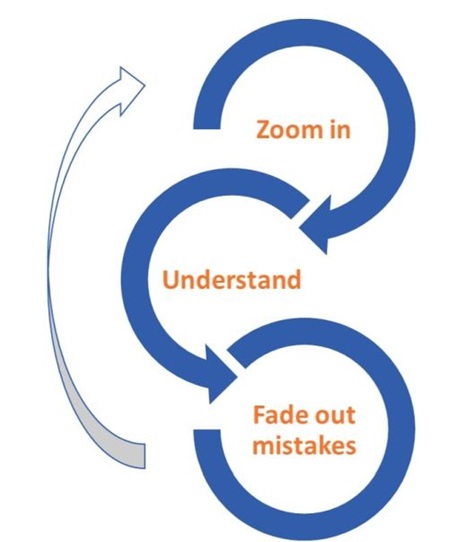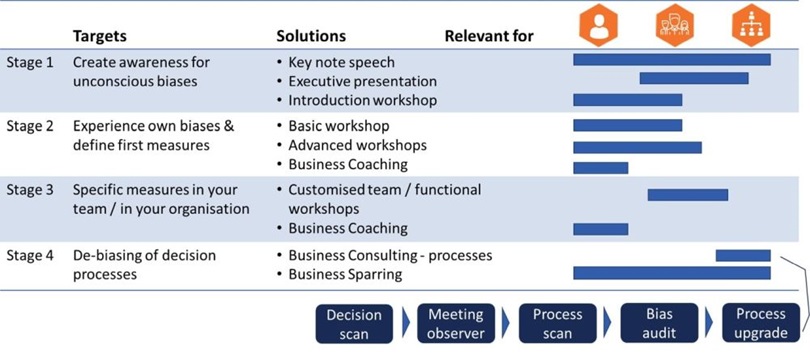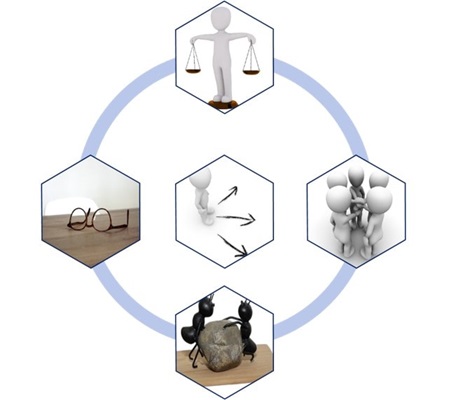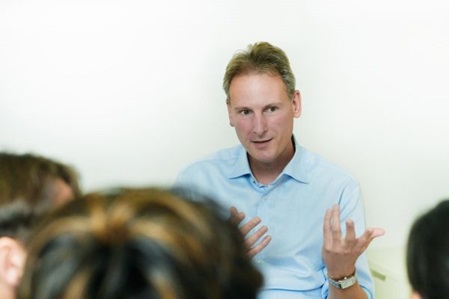De-biasing - breaking through thought patterns and effectively reducing biases
The innovative de-biasing concept makes it possible step by step: to break through ingrained thought patterns and thus effectively reduce unconscious biases.
Focusing on the essential issues allows to increase the quality of assessments, decisions and their implementation - for the concrete benefit of you, your team or your organisation!
De-biasing - reducing unconscious biases in a targeted and effective way
De-biasing - implementing exciting findings from behavioural economics
The unconscious bias definition as well as the discussion of the background for biases suggest that countermeasures must have different characteristics.
Wikipedia understands the term de-biasing as "... the reduction of bias, particularly with respect to judgment and decision making." In the German version it describes it as "... measures or a bundle of measures aimed at reducing negative effects due to cognitive biases." (translated)
The findings of behavioural economics form an important basis for many measures. This field has established itself as a new scientific discipline in recent decades - reinforced by the awarding of Nobel Prizes to Daniel Kahneman and Richard Thaler, for example.
The practical challenge: to design de-biasing in such a way that an effective practical transfer can take place. Only this really helps individuals, teams or organisations.
De-biasing - similar terms
Most collective terms for the reduction of unconscious biases refer to similar activities.
In addition to the term de-biasing used by Mind your business, debiasing, un-bias or anti-bias can also be found.
A more comprehensive concept such as de-biasing by Mind your business is rarely encountered; often unconscious bias training is meant by the various terms.
What is the benefit of de-biasing?
The benefit of countermeasures to biases results from:
- the concrete active biases,
- their effects and
- the context.
An individual may be able to avoid a regularly repeated mistake on the job, increasing recognition and performance appraisal.
A company, for example, may be able to eliminate a systematic error in the evaluation of investment projects and thus select more profitable projects, which increases financial results.
The questions therefore arise,
- which activities and actions have the greatest impact, both positive and negative, and
- how good the quality of the current decisions is.
Especially in a corporate context, this is not always clear - an analysis is therefore recommended to ensure clarity (a suitable offer for this is the Decision Scan).
De-biasing has great potential for significant decisions - the improvement of decision quality, especially in the corporate context, has an extremely positive effect on the achievement of goals!
Central to this: focus - it makes little sense to address all identified biases at the same time. It is advisable to start where the greatest potential lies - and you should know that!
De-biasing - major companies are already working on implementation
As central positive effects in the corporate context, McKinsey has ascertained that
- de-biasing of decision-making processes is significantly more important than the analysis of data - by a factor of 6!
- the profits of companies benefit from de-biasing - they are 7% points higher than companies that do not de-biase.
In recent years, well-known companies have recognised the importance of de-biasing. US based companies in particular, such as Facebook or Google, are working on targeted measures for their employees.
You are therefore in good company if you define and implement de-biasing measures in a targeted manner!

In a McKinsey survey of board members, reducing biases in decision-making processes was cited as the top strategic goal.
De-biasing needs individual and targeted measures
Unconscious biases are deeply rooted both on a personal level and in corporate cultures and processes. They easily cause "blind spots", especially at the core of the business. Thinking errors and distorted perceptions thus pose a significant risk to success, and in the worst case, to the existence of the organisation.
Biases are always individual - specific and individual measures are therefore needed, depending on the context, the personal environment or business model and the relevant decision-making processes.
An "off the shelf" training, whether face-to-face or online, cannot be more than an introduction to the topic - it does not solve the deeper issues!
The latter is a central criticism of unconscious bias training.
Therefore, a more comprehensive, yet flexible concept is needed to define effective measures against unconscious biases and to put them into practice!

The de-biasing concept of Mind your business
De-biasing is a process, not a one-off event.
It is possible to take the first small steps by dealing with the topic once. Effective measures against unconscious biases are usually connected with more extensive changes - changes in individual patterns or processes or structures in companies.
The de-biasing concept of Mind your business takes this into account.

Three steps to reduce biases
Step 1: Zoom in - go deep
Biases are difficult to grasp; most people are not aware of their own thinking errors. Therefore, it is important to first gain experience with them and to get explanations about their background and effects.
The point is to recognise and become aware of the relevant biases. This helps to understand the concrete fields of application and to put the effects of actions, one's own and those of others, into the respective context.
Step 2: Understand - Understanding
In the second step, this leads to becoming more sensitive - you understand which biases are at work in your practical context. Your self-perception becomes sharper, you intensify your observation of others. Understanding the different unconscious biases leads to becoming more aware of their relevance when necessary.
Step 3: Fade out mistakes - fix mistakes
You start changes and implement specific de-biasing measures - in yourself or in your organisation. You will receive feedback and experience the impact of the measures you have chosen. You will succeed in gradually reducing biases, from which you will learn and experience positive results. This often radiates to others, adding to the positive momentum.
It is important to understand that after going through the three steps, there is usually not yet a complete solution. Changing patterns (hence our system 1) or behaviour is a process.
Rather, there is a loop back to the start - the experience gained during implementation makes it possible to go further in depth, to sharpen perception and thus to take further action.
![]()
This concept is broadly applicable - it supports individuals, teams as well as entire organisations or their functions.
The steps are the same, but the contents are highly variable and individually adapted - the reduction of biases can neither be achieved by a single instrument (such as an Unconscious Bias Training) nor by standardised contents.
The tools and their application at different levels is the second essential element for successful de-biasing.
Where is the best place to start?
Most people have not yet dealt with their unconscious biases. The topic may seem rather abstract and difficult to grasp at first.
Usually there are patterns or outcomes that one judges as unpleasant or negative such as:
- making the same mistake over and over again,
- missing an important decision or making the wrong one,
- not moving away from one's own "bubble" or "going in circles" mentally,
- regularly failing to meet expectations and goals as an organisation, or
- repeatedly failing to implement decisions.
These are indicators that biases are likely to be active. The practically oriented approach of Mind your business allows you to start in the area that is concretely most relevant.
The new system of unconscious biases allows you a direct access in the most appropriate of the five subject areas:
- Perception
- Judgement
- Decision
- Interaction
- Implementation
You should not have to worry about psychological theory, but be able to start directly from the concrete "pain point"!
Feel free to contact me for an individual recommendation of your optimal starting position!
Breaking thought patterns - applying de-biasing in several stages
Different instruments for different goals
You have defined your starting point, for example you want to improve the quality of your decision-making as an individual or you want to assess market demand more realistically in your marketing function.
The question arises how you can break through your existing thought patterns, develop new behaviours or make structures in your organisation bias-free.
My interest in de-biasing arose precisely because of such questions in practice. Unconscious biases are complex, and reducing them usually requires focus and a process that goes through several stages. Within these stages there are concrete tools that are always built around the three steps to reduce biases.
These tools are based on many years of practical experience and have worked well both individually and in organisations.
The four stages of de-biasing
Your de-biasing journey is oriented towards your goals - from the following four stages you will receive those elements that will take you further.
The four stages are interrelated, but of course do not have to be completed in full and in order. What is important is that you only extract and implement what fits your context best.
No more and no less.
Feel free to contact me for a first meeting and to clarify your concrete goals - we will find an individual package that makes them realisable - step by step.

De-biasing instruments and solutions
Here you will find further information on all instruments and solutions - for you, for your team and for your organisation.
- Key notes & impulse lectures
- Impulse series
- Free information lectures
- Workshop formats
- Business Coaching
- Business Sparring
- Business Consulting
De-biasing vs nudging
The question of the difference between de-biasing and nudging is asked frequently.
There are three main differences:
- Goal - nudging primarily aims for compliance (hence a specific, wanted behaviour), de-biasing is oriented towards the goals of the particular person or organisation affected by biases.
- Awareness of biases - while this is not necessary for the effectiveness of nudging, experiencing and understanding one's own biases plays an essential role in de-biasing.
- Level - Nudging focuses on a large number of people who are supposed to show a certain behaviour. De-biasing, on the other hand, always starts individually.
Nudging has valuable areas of application (for example in the field of safety). Compared to de-biasing, it is strongly "top-down" oriented and not based on individual goals.


